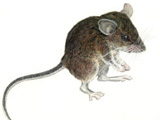|
|
TODAY.AZ / Weird / Interesting
Seven new species of mammals discovered in Philippines
22 June 2011 [15:06] - TODAY.AZ
A group of American and Filipino biologists have discovered seven previously unknown species of mammals in the Philippines, increasing the number of native mammals known from Luzon Island (excluding bats) from 42 to 49 (17%).
 The formal descriptions of the seven species, all of which are members of the genus Apomys, were published on May 20, 2011 in Fieldiana, the peer-reviewed journal of The Field Museum, where the project is based. The nine co-authors included biologists from the University of the Philippines, the Philippine National Museum, Conservation International-Philippines, Utah Museum of Natural History, and Florida State University.
The formal descriptions of the seven species, all of which are members of the genus Apomys, were published on May 20, 2011 in Fieldiana, the peer-reviewed journal of The Field Museum, where the project is based. The nine co-authors included biologists from the University of the Philippines, the Philippine National Museum, Conservation International-Philippines, Utah Museum of Natural History, and Florida State University."These animals are part of the rich biological heritage of the Philippines," said Dr. Theresa Mundita Lim, Director of the Protected Areas and Wildlife Bureau, Department of the Environment and Natural Resources (DENR). "The forests where they live are crucial watershed areas for Manila and many other cities. Protecting their mountain forest habitat is good for them and for people." The DENR is a collaborator of the project, providing assistance at field sites and co-organizing conferences on wildlife and conservation.
All of the species are forest mice, and each species lives only in a small part of Luzon. According to Dr. Lawrence Heaney from The Field Museum, project leader and lead author of the publication, "These are wonderful little mice that live in forested regions high in the mountains. Although they are often abundant, they actively avoid humans and rarely cause any harm. They prefer to eat earthworms and seeds on the forest floor."
Two of the new species live only in the Zambales Mountains (on Mt. Tapulao), two live only on Mt. Banahaw (south of Manila), two only in the Mingan Mountains of Aurora Province, and one lives only in the Sierra Madre of northeastern Luzon.
"It is extraordinary that so many new species of mammals remain to be discovered in the Philippines," according to Danilo Balete, leader of the project's field team. "In the past 10 years we've published formal descriptions of 10 other species, and other biologists have described five more. And we are nowhere close to the end of our discoveries. The Philippines may have the greatest concentration of unique species of animals of any country in the world."
Dr. Scott Steppan, co-author and head of the laboratory at Florida State University where the DNA portion of the study was conducted, said, "The Philippines is an ideal place to study the evolution of animal diversity, even better than the famous Galapagos Islands. These animals have been evolving in the Philippine archipelago for millions of years."
Mr. Romeo Trono, Country Executive Director for Conservation International -- Philippines, said, "Protecting land and marine resources is key to maintaining healthy ecosystems which deliver ecosystem services such as food, clean water, health, tourism and cultural benefits and stable climate which are vital to the very survival of every Filipino. Although small in size, these little animals are part of our biodiversity which forms the basic foundation of healthy ecosystems."
M. Josefa Veluz, biologist at the Philippine National Museum and co-author of the study, pointed out that the new species from the Sierra Madre and Mt. Banahaw live within protected areas, but those from the Mingan Mountains and Zambales do not. Logging, expansion of agriculture, and mining all have an impact on wildlife and watersheds, she said.
/Science Daily/
URL: http://www.today.az/news/interesting/88820.html
 Print version
Print version
Views: 1998
Connect with us. Get latest news and updates.
See Also
- 19 February 2025 [22:20]
Visa and Mastercard can return to Russia, but with restrictions - 05 February 2025 [19:41]
Japan plans to negotiate with Trump to increase LNG imports from United States - 23 January 2025 [23:20]
Dubai once again named cleanest city in the world - 06 December 2024 [22:20]
Are scented candles harmful to health? - 23 November 2024 [14:11]
Magnitude 4.5 earthquake hits Azerbaijan's Lachin - 20 November 2024 [23:30]
Launch vehicle with prototype of Starship made its sixth test flight - 27 October 2024 [09:00]
Fuel prices expected to rise in Sweden - 24 October 2024 [19:14]
Turkiye strikes terror targets in Iraq and Syria - 23 October 2024 [23:46]
Kazakhstan supplied almost entire volume of oil planned for 2024 to Germany in 9 months - 23 October 2024 [22:17]
Taiwan reported passage of Chinese Navy aircraft carrier near island
Most Popular
 Separatists & Pashinyan - the farce continues
Separatists & Pashinyan - the farce continues
 4SIM signs MoUs with Chinese institutions to boost cooperation in green and industrial technologies
4SIM signs MoUs with Chinese institutions to boost cooperation in green and industrial technologies
 Collapse of "macaronism": Resignation of the "grey cardinal" of France may cause a chain reaction
Collapse of "macaronism": Resignation of the "grey cardinal" of France may cause a chain reaction
 Paris hosts debut of Azerbaijan’s first AI art “Shusha”
Paris hosts debut of Azerbaijan’s first AI art “Shusha”
 Foreign diplomats tour liberated cities of Khankendi and Shusha
Foreign diplomats tour liberated cities of Khankendi and Shusha
 Khojaly victim testifies at Baku Military Court: “Madat Babayan’s gang tortured me”
Khojaly victim testifies at Baku Military Court: “Madat Babayan’s gang tortured me”
 Somalian minister praises Türkiye’s role in peace and development
Somalian minister praises Türkiye’s role in peace and development
